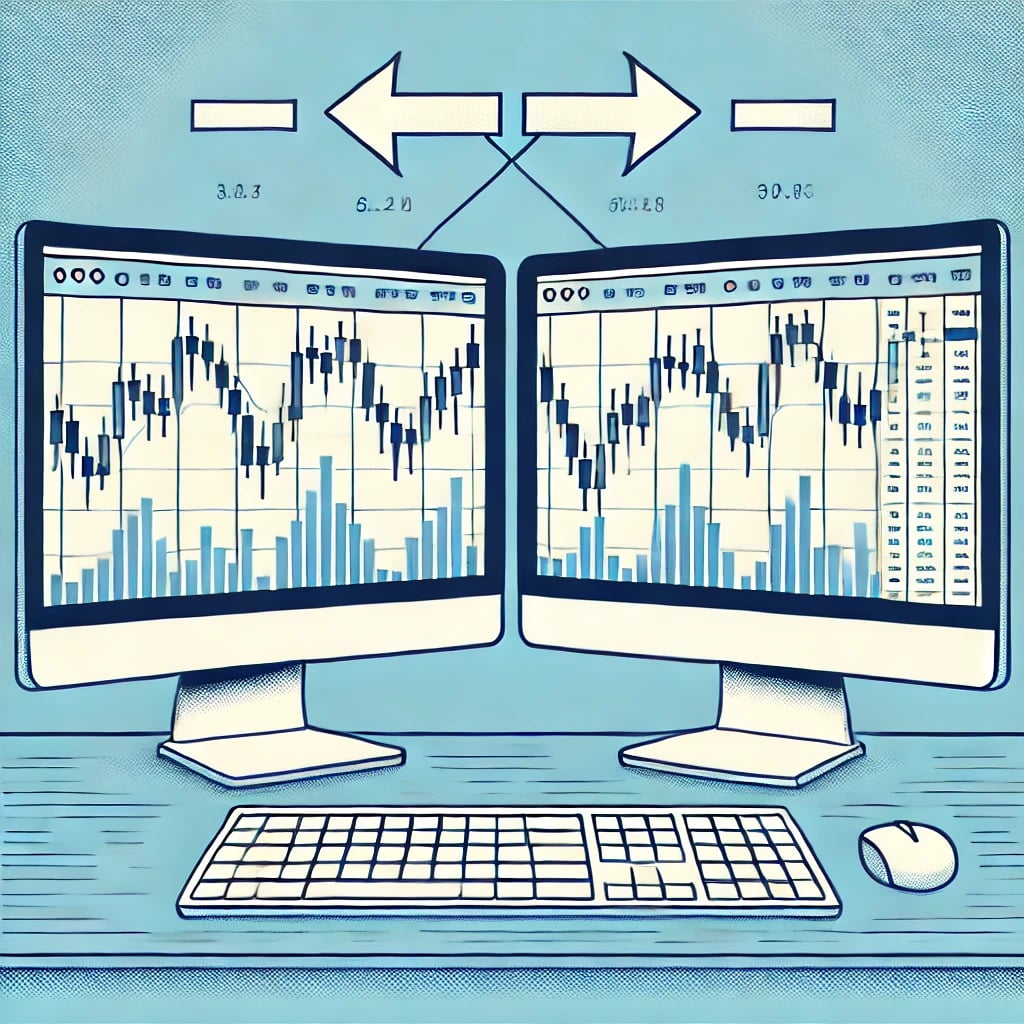
Enter the world of synchronized trading with Mirror Trading. This guide decodes the concept’s essence, mechanisms, and how it empowers traders to replicate strategies of experienced investors, fostering diversified and informed trading experiences.

Mirror trading, also known as copy trading or social trading, is a strategy used in the foreign exchange (Forex) markets. It allows investors to replicate the trades of experienced forex traders and execute the same transactions in their own accounts.
Key Takeaways:
- Mirror trading enables investors to replicate the trades of experienced forex traders.
- Investors can select algorithmic strategies based on their investment goals and risk tolerance.
- Automated software replicates trades and aims to generate returns similar to the chosen strategies.
- Mirror trading eliminates emotional decision-making and saves time for investors.
- By trading multiple strategies concurrently, investors can diversify risk.
What is Mirror Trading
Mirror trading is a versatile methodology applicable to both Forex and stock markets, with a predominant focus on the dynamic world of foreign exchange.
How It Works
Traders employing mirror trading select a specific strategy and, using automated processes, seamlessly duplicate the trades executed by the chosen strategy in their brokerage account. This not only streamlines the trading process but also opens doors for traders to explore strategies in both Forex and stock markets.
Strategy Selection
Investors can select algorithmic strategies based on:
- Investment goals
- Risk tolerance
- Available capital
- Desired assets
These strategies are executed using automated software, which runs 24/5 to replicate trades and strive to produce returns similar to the chosen strategies.
Benefits
Mirror trading eliminates emotionally-driven trading decisions as it relies on predetermined strategies. It offers beginners the opportunity to learn from and mimic the strategies of professional traders. By automating trading, it saves time by only requiring investors to focus on market aspects in which they excel. Additionally, mirror trading allows investors to diversify risk by trading multiple strategies concurrently.
Mirror trading, at its core, hinges on two pivotal aspects that form the backbone of its functionality—Fundamentals and Investments. Understanding these key elements is essential for investors looking to harness the potential of mirror trading.

Fundamentals of Mirror Trading: A Blueprint for Success
The fundamentals of mirror trading revolve around the meticulous replication of successful trading strategies. In this context, investors leverage signal services and auto-trading services as the building blocks for executing trades. By closely copying the actions of seasoned traders, mirror trading allows individuals to tap into the expertise of those who have demonstrated success in navigating the complex trading landscape.
For instance, consider a scenario where an experienced forex trader consistently employs a particular set of technical indicators and risk management strategies to achieve profitable outcomes. Through mirror trading, an investor can adopt these precise strategies without the need for an in-depth understanding of technical analysis. This fundamental approach streamlines the trading process, making it accessible to a broader spectrum of investors.
Investments in Mirror Trading: Scaling Opportunities
Mirror trading is inherently linked to the notion of substantial investments, presenting an avenue for traders seeking to engage in larger-scale transactions. Unlike conventional trading methods that may require constant monitoring and decision-making, mirror trading allows investors to scale their involvement by following strategies aligned with their risk appetite and financial goals.
For example, consider an investor with a significant capital base who wishes to diversify their portfolio across various currency pairs. By strategically selecting mirror trading strategies that match their risk tolerance, this investor can allocate funds across multiple trades simultaneously. This not only spreads risk but also opens doors to diverse investment opportunities in the exchange market.
Strategic Implementation and Diversification
Once investors grasp the fundamentals and recognize the potential for substantial investments, the next step is strategic implementation. Mirror trading empowers traders to align selected strategies with their unique preferences, including risk tolerance and past profitability. This strategic alignment ensures that the chosen trading methods resonate with the investor’s overall financial objectives.
Diversification, a key principle in investment strategy, is seamlessly integrated into mirror trading. Investors can concurrently trade multiple strategies, spreading their risk across various assets and trading approaches. This not only enhances the resilience of the investment portfolio but also allows for a more comprehensive exploration of the diverse opportunities the financial markets present.
Copy Trading vs. Mirror Trading
In social trading, two concepts stand out—Copy Trading and Mirror Trading. While these terms are sometimes used interchangeably, it’s essential to delve into their nuances to make informed decisions as an investor.

Understanding Copy Trading: Direct Copying of Trader Moves
Copy Trading involves a direct replication of the moves made by an individual trader. In this scenario, an investor selects a specific trader, often referred to as a signal provider, and mirrors their trades in real-time. Essentially, the investor’s account shadows the actions of the chosen trader, creating a symbiotic relationship where any trade executed by the signal provider is duplicated in the investor’s account.
For instance, if Trader A has a successful track record of consistently profiting from specific currency pairs, an investor opting for Copy Trading would replicate Trader A’s exact trades. This approach is suitable for those who prefer a hands-off approach to trading, relying on the expertise of a particular individual rather than algorithmic strategies.
| Aspect | Copy Trading | Mirror Trading |
|---|---|---|
| Basis | Direct replication of a single trader’s actions | Algorithmic strategies derived from multiple traders |
| Execution | Manual or automatic replication of trades | Fully automated execution based on developed algorithms |
| Control Level | Low, relies on the chosen trader’s decisions | Moderate, relies on diversified algorithmic strategies |
| Risk Management | Dependent on the chosen trader’s performance | Diversified, mitigates risk across multiple strategies |
| Suitable For | Hands-off investors preferring direct expertise replication | Investors valuing algorithmic precision and diversity |
| Example | Replicating Trader A’s trades on specific currency pairs | Combining Trader B’s trend analysis and Trader C’s reversal patterns |
Unpacking Mirror Trading: Algorithmic Precision and Diversity
Mirror Trading, on the other hand, introduces a layer of sophistication by relying on algorithms developed from the trading patterns of multiple successful traders. Instead of directly mimicking a single trader, investors can choose strategies that amalgamate the successful approaches of various traders. The automated execution of trades based on these algorithms adds precision and diversity to the trading strategy.
For example, if Trader B excels in trend analysis while Trader C has a knack for identifying reversal patterns, an investor engaged in Mirror Trading can leverage both these strategies simultaneously. This not only mitigates risk by diversifying the trading portfolio but also harnesses the strengths of different trading methodologies.
Choosing Between Copy Trading and Mirror Trading: Factors to Consider
The decision between Copy Trading and Mirror Trading depends on the investor’s preferences, risk tolerance, and desired level of control. Copy Trading is straightforward, offering a direct replication of individual trader actions, suitable for those who prefer a more passive approach. In contrast, Mirror Trading provides a more sophisticated and diversified strategy, appealing to investors who value algorithmic precision and a broader spectrum of trading approaches.
Before embarking on either path, investors must consider the transparency and track record of the traders or algorithms they plan to follow. Brokers offering these services typically review and validate the performance of added strategies, aiding investors in making informed choices.
Benefits of Mirror Trading for Investors
Learning from Professional Traders
Mirror trading provides several benefits for investors, especially beginners. Firstly, it offers the opportunity to learn from and mimic the strategies of professional traders. This can be a valuable learning experience, allowing investors to gain insights into successful trading techniques and avoid common pitfalls. By replicating the trades of experienced traders, investors can potentially achieve similar results and improve their trading skills over time.
Eliminating Emotional Decision-Making in Trading
Another benefit of mirror trading is the elimination of emotional decision-making. This is particularly important in the forex market, where emotions can easily cloud judgment and lead to irrational trading decisions. With mirror trading, investors can rely on the automated software to execute trades based on the selected strategy’s parameters, removing the influence of emotions and ensuring a disciplined approach to trading.
Time-Saving Advantages of Mirror Trading
Furthermore, mirror trading can save investors time by allowing them to focus only on market aspects in which they excel. Instead of spending hours analyzing the market and searching for trading opportunities, investors can rely on the algorithmic strategies of experienced traders to identify profitable trades. This frees up time for investors to focus on other important aspects of their trading activities or pursue other interests.
Diversifying Risk with Mirror Trading
- Multiple Strategies: Mirror trading provides the opportunity to diversify risk by trading multiple strategies concurrently.
- Risk Spread: By selecting and mirroring different strategies, investors can spread their risk across various market dynamics.
- Consistent Profits: This approach may enhance their chances of generating consistent profits.
Conclusion on the Benefits of Mirror Trading
In conclusion, mirror trading is a strategy that allows investors to replicate the trades of experienced traders through automated software. It offers a range of benefits, including the ability to learn from professionals, eliminate emotional decision-making, save time, and diversify risk. However, it is crucial for investors to thoroughly research and understand the strategies they choose to mirror and actively monitor their accounts to avoid potential risks.
FAQ
What is mirror trading?
Mirror trading is a type of trade selection primarily used in the foreign exchange (Forex) markets. It allows investors to replicate the trades of experienced forex traders and execute the same transactions in their own accounts.
How does mirror trading work?
Mirror trading works by enabling investors to mirror the trades of experienced traders through automated software. Investors can access a trading platform provided by a brokerage to analyze the performance and details of various trading methods. They can then select an algorithmic strategy that aligns with their investment goals and risk tolerance. The selected strategy’s trades are replicated in the investors’ accounts using automated software, aiming to generate returns similar to the original trades.
What are the benefits of mirror trading?
Mirror trading offers several benefits, including the ability for beginners to learn from and mimic the strategies of professional traders, eliminating emotional decision-making, and saving time by focusing only on market aspects in which they excel. It also provides the opportunity to diversify risk by trading multiple strategies concurrently.
What are the risks and limitations of mirror trading?
One of the main risks of mirror trading is the importance of choosing the right trader or strategy. Picking a poor strategy or trader could result in potential capital loss. Additionally, mirror trading involves relying on automated software to execute trades, which means investors do not have direct control over their trades and must trust the algorithm being used. Delay in order execution can also impact the effectiveness of mirror trading, particularly during times of market volatility. Furthermore, mirror trading may not be suitable for all investors and may be less effective in certain market conditions.

















